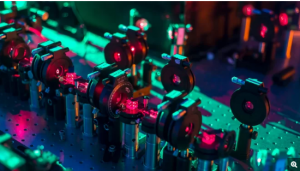When Mile Gu boots up his new computer, he can see the future. At least, 16 possible versions of it — all at the same time.
Gu, an assistant professor of physics at Nanyang Technological University in Singapore, works in quantum computing. This branch of science uses the weird laws that govern the universe’s smallest particles to help computers calculate more efficiently.
Unlike classical computers, which store information as bits (binary digits of either 0 or 1), quantum computers code information into quantum bits, or qubits. These subatomic particles, thanks to the weird laws of quantum mechanics, can exist in a superposition of two different states at the same time.
Just as Schrödinger’s hypothetical cat was simultaneously dead and alive until someone opened the box, a qubit in a superposition can equal both 0 and 1 until it’s measured. Storing multiple different outcomes into a single qubit could save a ton of memory compared to traditional computers, especially when it comes to making complicated predictions.
In a study published April 9 in the journal Nature Communications, Gu and his colleagues demonstrated this idea using a new quantum simulator that can predict the outcomes of 16 different futures (the equivalent of, say, flipping a coin four times in a row) in a quantum superposition. These possible futures were encoded in a single photon (a quantum particle of light) which moved down multiple paths simultaneously while passing through several sensors. Then, the researchers went one step further, firing two photons side-by-side and tracking how each photon’s potential futures diverged under slightly different conditions.
more at livescience.com
Ask me anything
Explore related questions





